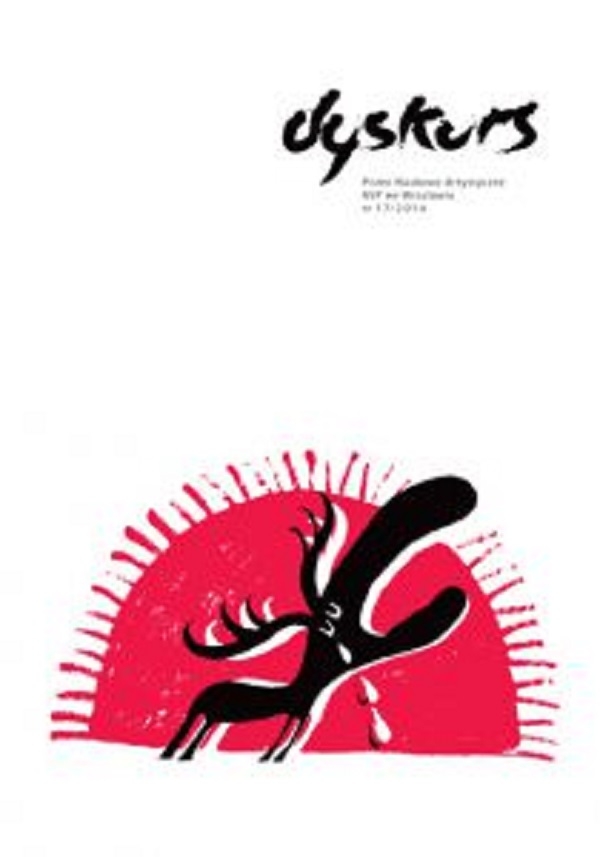„Eine herrliche Entspannung in einer blöden Zeit“– Die Breslauer Jahre Oskar Schlemmers
Abstract
‘Great Relaxation in Absurd Era’— Oskar Schlemmer’s Years in Wrocław
The years from 1929 to 1932 were important, creative and critical period in Oskar Schlemmer’s life. In October 1929, after nine rich in events years spent at the Bauhaus in Weimar and Dessau, Schlemmer was appointed by Oskar Moll a professor at the State Academy of Arts and Crafts in Wroclaw and started teaching. His first class was entitled Man and Space. He continued teaching it until its closure in 1932. Aesthetic analysis of the paintings created during that period explains the ambiguity and ambivalence which Schlemmer found in Wroclaw. Years in the Silesian capital were not only a cheerful chapter in his biography. In his letters, he described his experience as ‘wonderful retreat after a boiler in Dessau’. It was a turning point in his career which he considered as ‘a threshold’ and/or a ‘transition’ which led, under the weight of impending disaster, to ‘absurd era’ in which he was branded a ‘Bolshevik artist producing destructive art with Marxist- Jewish elements’. He was a victim of mindless ignorance, deliberately calculated political attacks and a far-reaching revision.
His years in Wrocław, the artist started in relaxed atmosphere borrowed from the Baroque artists art historians consider it as ‘Silesian Baroque’. In that style, he painted The Group with the Blue Ecstatic Figure 1931 and The Group in Imagined Architecture 1930 and The Group of 15 People before Entering a Stadium 1930. The pictures revealed greate spontaneity, sensual color accords and flickering light which outlined curved lines. ‘Classical’ and ‘Neo-classical’ Schlemmer considered ‘Baroque’ influence as dangeaours because it included the element of ‘mannerism’. He returned to painting geometric-architectural motifs. This time there were stairs and railings. Within two years, he painted a series entitled The Group at the Handrail, At the Handrail and At the Stairs. The best-known picture from that period is entitled The Bauhaus Stairway.
The series is considered as the key to understanding the groundbreaking nature of Wroclaw years in Schlemmer’s career. The handrail reveals what is essential. It is not an addition to the background, but the result of— in part intended, in part resulting from the subconscious and intimate game of the artist who is desperately looking for support while facing empty staircase which are, in fact, open public space also: living space. The handrail is not an elusive detail. In accordance with its intended function it is used as support. The motif draws on-looker’s tention and subdues wandering eye, which follows the line is silence. A person looking at the picture pays as much attention to the handrail and to the figures shown in the picture. The handrail is the focal point in the same sense which Roland Barthes used when he wrote about photography. It runs out of the picture and pierces the viewer sideways or running horizontally escapes to the sides thus demonstrating its expansive strength and duration. It ‘cuts’ the image and divides it into parts, but it also is a passage, like a staircase, which opens up the prospect of aesthetic, biographical and historical spheres. It stores ‘a program of action’, which demands execution. This is a paradox situation: the handrail is always connected with its location but leads towards different area. While giving support, it does not make us a prosiner of any space. While ‘grabbing everything’, Schlemmer and people who look at his pictures ‘grab’ the railing. Karin von Maur justly said that Schlememr’s images of handrail revealed the artist’s innermost need to find support. It was not only the need to obey formal rules, sthrengthening of composition, but also the need to self-control and to minimize the Baroque forms and colors. It was not only Schlemmer’s admiration for Mondrian whom he met in1930 in Paris, but also internal, mental the needs of the artist. Handrail meant for him the support he could use against irrational, subconscious forces, which he wanted to control and exploit rationally.

